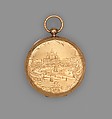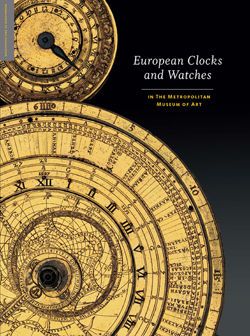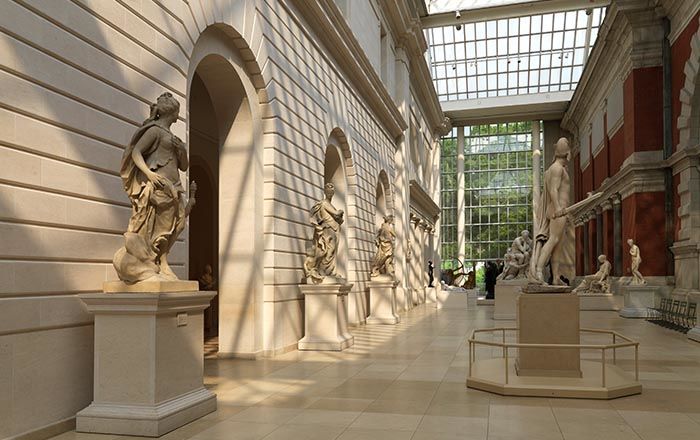Hunter-case pocket watch
Watchmaker: Firm of Vacheron and Constantin Swiss
Partnership of Jacques Barthélémi Vacheron Swiss
and François Constantin Swiss
Not on view
An extended trip, commonly known as the Grand Tour, was intended to acquaint wealthy young Englishmen and Europeans, many of them recent recipients of classical educations, with firsthand knowledge of the monuments of Greek and Roman antiquity, as well as the splendors of Italian Renaissance art and architecture.[1] The custom began in the late sixteenth century, and by the eighteenth and nineteenth centuries many notable English and Northern European collectors of paintings and classical antiquities had enriched their collections with purchases made in the course of a tour. One of the more ambitious purchases, a third-century Roman marble sarcophagus now in the Metropolitan Museum, was transported in 1728 from Rome by the English third Duke of Beaufort and installed in his country estate in Badminton, Gloucestershire (55.11.5).[2] Such sightseeing came to a halt in the unsettled times of the late eighteenth century when the French Revolutionary Wars (1792–1802) were followed by the Napoleonic Wars (1803–15). Travel became practical again after the defeat of Napoleon at Waterloo in 1815, when travelers flocked to Italy, especially Rome, and brought back mementos, though rarely on the scale of the Badminton sarcophagus.
Several watches in the Museum’s collection belong to this period of travel, among them the gold pocket watch with a bird’s-eye view of Saint Peter’s Square in Rome on the cover. Another watch in the collection by the same makers depicts the Campidoglio, also in Rome,[3] providing evidence that the Saint Peter’s watch was primarily intended not as a souvenir for a religious pilgrim (although certainly appropriate for that market) but for travelers making a Grand Tour. Still another watch displays the Roman Colosseum on its cover.[4] The demand for these watches coincided nicely with the rise of watchmaking firms in Switzerland that could supply merchants in Italy and France with handsome souvenirs, sporting scenes of the monument visited or the object viewed that could remind the traveler of the journey and impress his acquaintances. Many of these watches were, in fact, the products of improved manufacturing techniques that allowed the Swiss to make respectable timekeepers in quantity that could be bought at relatively reasonable prices.
One of the most successful Swiss firms and certainly the longest surviving is Vacheron (eventually Vacheron and Constantin), which was founded by Jean-Marc Vacheron (1731–1805), who opened a workshop in Geneva in 1755.[5] He was succeeded by his son Abraham Vacheron (1760–1845), who married Anne-Elisabeth Girod in 1786, forming a partnership with his father-in-law.[6] Their watches were signed “A. Vacheron Girod.”[7] By 1816, Jean-Marc’s grandson, Jacques Barthélémi Vacheron (1787–1864), was traveling to Italy and soon selling watches in Turin and Milan.[8] Shortly thereafter, in 1819, he entered into partnership with François Constantin (1788–1854) and the firm became known as Vacheron and Constantin. Records show that a carriage was bought for trips to France and Italy, [9] and as the representative abroad, Constantin began traveling with a large trunk full of the firm’s products. [10]
In 1839, George-Auguste Leschot (1800–1884), the son of Jean- Frédéric Leschot (1746–1824), who was the automaton maker and partner of Henri-Louis Jaquet-Droz (1752–1791), was contracted by the Vacheron and Constantin firm to supply technical improvements to the manufacturing of their watches.[11] While specialists had long made blanks (ebauches), or plates, for individual watch movements, these and other watch parts often needed considerable adjustments and other hand-finishing when a watch was assembled. Other specialists made individual parts of the movement, while still others specialized in escapements. The components were assembled in one place, fitted together, polished, gilded, and cased under the supervision of a master watchmaker, who was often the marketer of the watch as well.
Much of this time-consuming work changed with the adoption of standardized sizes and layouts (calibers) of movements. Vacheron and Constantin, like many other watchmakers, adopted layouts of movements that were invented by the French clockmaker Jean-Antoine Lépine (1720–1814), who radically diminished the thickness of a watch in 1770 (or 1772). He did so by doing away with the fusee and relying on a going barrel alone for the regulation of the power produced by the mainspring as it uncoiled, and substituting a relatively flat, or horizontal, escapement (usually a cylinder or virgule) for the verge in some of his watches. In place of a back plate, Lépine’s layout pivoted the wheels of the train on a series of separate cocks (bridges, or bars), each one screwed to the front plate of the watch.[12] These parts were produced in standardized sizes so that a watch could be assembled and finished in considerably less time than under the old, so-called puttingout system. The layout employed in the Museum’s watch is similar to the one Lépine began using about 1795.[13]
Leschot became a full-time member of the Vacheron and Constantin firm in 1844.[14] Among his contributions were the application of a pantograph for precisely duplicating the plates of watches in standardized sizes based directly on a single technical drawing or template.[15] He also developed machinery for manufacturing uniform components for the chosen size (or caliber) of the watch, and he added improvements and promoted the adoption of the detached lever escapement, more durable and more easily made than the cylinder escapement in general use at the time. His watchmaking machinery enabled Vacheron and Constantin to produce watches of standardized sizes that needed much less fitting than before. While the first use of truly interchangeable parts for watches and their incorporation into a factory system was probably by the American watchmakers Aaron L. Dennison (1812–1895) and Edward Howard (1812–1904) in the 1850s,[16] or perhaps by the itinerant Swiss watchmaker and mechanician Pierre Frédéric Ingold (1787–1878) in the 1840s,[17] the new speed and ease of production at Vacheron and Constantin in the 1840s enabled the firm to expand their output greatly. Swiss and American production eventually outstripped all others.[18]
The Museum’s watch was finished, according to the firm’s records, in 1844.[19] Housed in a thin Hunter-style case, the movement has a Lépine layout but retains a cylinder escapement instead of the more up-to-date lever escapement. The front cover of the case is engraved with a view of Saint Peter’s Square, bordered at the top by a Gothic-inspired ornamental design, and at the bottom by one reminiscent of the baroque. It is hinged to the reeded band of the case at the nine o’clock position, and when opened it reveals a white enamel dial covered by glass held in place by a thin gold bezel. The dial is painted with black enameled roman numerals (I–XII) for the hours and individual strokes for the minutes. Remarkably slim gold hands of the Breguet type and the firm’s name, “VACHERON ET CONSTANTIN,” painted at the four o’clock position complete the simple but elegant design.
The back cover is hinged at the seven–eight o’clock position and is engraved with two winged, airy spirits holding up a large basket of flowers. A gold inner cover has an engine-turned pattern and the polished gold label of Vacheron and Constantin at the top. Another label of polished gold at the bottom is engraved “a Geneve” and, in between, a decorative cartouche has the words echappement / horizontal (cylinder escapement); “Aguilles” (hands); “n. 44631” (serial number); and quatre trous / rubis (four ruby endstones). There are also two holes in the cover, one for setting the hands, as indicated, and one for winding the mainspring with a key. The cover, too, is hinged to the band of the case at the seven–eight o’clock position.
The ball-shaped pendant and the ring are suitably shaped and ornamented, and they are attached to the movement at the three o’clock position so that when the front cover is released, the watch can easily be held in one hand and read in a horizontal position, or Hunter-style.
The Lépine-type layout of the movement consists of a going barrel for the mainspring and a three-wheel train held in place by four brass bridges screwed to the single plate. The bridge for the balance is engraved with a scale marked “AVANCE / RETARD” accompanied by a hand for adjusting the hair spring; the bridge for the first wheel of the train (the center bridge) is marked “VACHERON & CONSTANTIN”; and the escapement is indeed a cylinder.
Interests similar to those that prompted visits to Italy also inspired sojourns in Paris, another of the traditional destinations of seekers of cultural enrichment and all but required of those on the Grand Tour. By the 1830s, the newly constructed galleries of the Cour Carrée additions to the old royal palace of the Louvre permitted the public to view sculptures and other antiquities from Greece and Rome, but also from Egypt. Egyptian antiquities had fostered a fashion in late eighteenth-century France of Egyptian motifs in decorative designs, a taste further encouraged by the French invasion of Egypt in 1798 and the ensuing survey of its antiquities, some of them ending in French possession. An Egyptian motif appears on another pocket watch (26.267.14) in the Museum’s collection that belongs to the category of upscale mementos for travelers.[20] It was made by the Geneva firm of Bautte and Moynier, the partnership of Jean-François Bautte (1772–1837) and Jean-Gabriel Moynier (1772–1840) that existed from 1826 to 1831.[21] It seems that Bautte, with an earlier partner, Jacques-Dauphin Moulinié (or Moulinier; active 1793–1828), had specialized in luxury watches with enameled and gemstone-ornamented cases, and he was selling his watches in Paris as early as 1795.[22] The back of the case of the Museum’s watch depicts a Ptolemaic (305–30 b.c.) sandstone bas-relief representing the constellations of the Egyptian zodiac, which was brought to France in 1821 from the Temple of Hathor in Dendera, Egypt, and given to the Bibliothèque Nationale de France, Paris.[23] The image is a fine example of the art of champlevé enamel then available in Geneva, and a document of Greco- Egyptian astronomy for both foreign and French cognoscenti.
The enamel at the top of the three o’clock numeral of the dial of the Vacheron and Constantin watch is damaged; there is a small scratch in the gold above the Vatican portion of the Saint Peter’s Square scene; and slight scratches appear on the cartouche with the serial number. There is a small piece of enamel missing from the two o’clock position on the back of the case of the Bautte and Moynier watch and several areas of enamel loss on both the pendant and ring. Both watches have been carefully preserved and are part of a large gift of nineteenth-century Swiss watches by an anonymous donor made in 1926 in memory of Lady May Fletcher-Moulton.
Notes (For key to shortened references see bibliography in Vincent and Leopold, European Clocks and Watches in the Metropolitan Museum of Art. NY: The Metropolitan Museum of Art, 2015)
[1] For an entertaining account of the custom, written largely from a British viewpoint, see Black 2003, pp. 3–16, 23, 46–67. See also Buzard 2002.
[2] Acc. no. 55.11.5.
[3] Acc. no. 26.267.71.
[4] Signed “D. Bachelard & Fils / A GENEVE.” Acc. no. 26.267.22. Little is known about the makers.
[5] For a watch of this date signed “J:M:Vacheron A GENEVE” in the collection of the present-day firm, see Treasures of Vacheron Constantin 2011, p. 25.
[6] See Pritchard 1997, vol. 2, p. v-3; Patrizzi 1998, p. 386. For genealogical tables of the family, see Pritchard 1997, vol. 2, p. v-4; Treasures of Vacheron Constantin 2011, pp. 32–33. A chronology of the company is provided in Cologni 2005.
[7] For the full range of signatures and trademarks used by the firm, see Pritchard 1997, vol. 2, pp. v-1, v-2; Treasures of Vacheron Constantin 2011, p. 34. See also 17.190.1503a, b in this volume for one of the watches signed “A. Vacheron Girod” in the Museum’s collection.
[8] Patrizzi 1998, p. 387; Cologni 2005, p. xxviii.
[9] Cologni 2005, p. xxviii. See also Jaquet and Chapuis 1970, p. 119, for an account of earlier Vacheron trade with Italy.
[10] Treasures of Vacheron Constantin 2011, p. 27.
[11] Jaquet and Chapuis 1970, p. 158. See also Treasures of Vacheron Constantin 2011, pp. 28–29.
[12] Chapiro 1980; Chapiro 1988, pp. 46, 93–106.
[13] Chapiro 2006, pp. 6–7, and fig. 3.
[14] Cologni 2005, p. xxix.
[15] An illustration of the pantograph together with eight examples of the same layout in eight sizes made possible by the machine appears in Jaquet and Chapuis 1970, pl. 111; see p. 158 for a more detailed description of the pantograph. See also Pritchard 1997, vol. 2, p. L-52.
[16] Harrold 1984, pp. 16–21; Hoke 1990, pp. 181, 188–89, 198; Hoke 1991, pp. 61–63.
[17] R. F. Carrington and R. W. Carrington 1978; Thompson 2008, pp. 124–25. See also Landes 1983, pp. 283–85.
[18] Landes 1983, p. 326, and app. b, pp. 380–84.
[19] The authors would like to thank the officials at Vacheron Constantin for providing this information from their records.
[20] Acc. no. 26.267.14.
[21] For more about Bautte and his various partnerships, see Pritchard 1997, vol. 1, pp. b-26 to b-30, and vol. 2, pp. m-106, m-107. See also Patrizzi 1998, p. 96.
[22] Jaquet and Chapuis 1970, pp. 146–47.
[23] Now in the Musee du Louvre, Paris, inv. no. D 38. For further discussion of the meaning of the constellations, see J. Evans 1998, pp. 39–40.
This image cannot be enlarged, viewed at full screen, or downloaded.
This artwork is meant to be viewed from right to left. Scroll left to view more.




